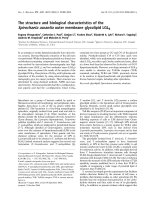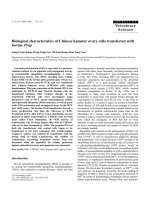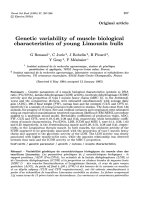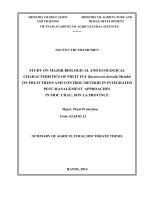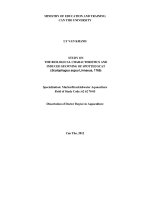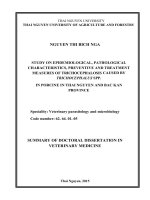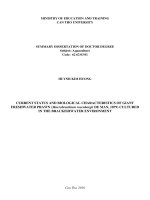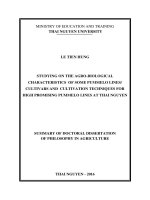Study on biological characteristics of beet armyworm spodoptera exigua (lepidoptera noctuidae) on green onion
Bạn đang xem bản rút gọn của tài liệu. Xem và tải ngay bản đầy đủ của tài liệu tại đây (4.29 MB, 78 trang )
VIETNAM NATIONAL UNIVERSITY OF AGRICULTURE
FACULTY OF AGRONOMY
UNDERGRADUATE THESIS
TITLE:
“STUDY ON BIOLOGICAL AND ECOLOGICAL
CHARACTERISTICS OF BEET ARMYWORM
SPODOPTERA EXIGUA (LEPIDOPTERA:
NOCTUIDAE) ON GREEN ONION”
Student
: Vu Thi Giang
Code
: 621749
Class
: K62KHCTT
Supervisor : Ph.D. Pham Thi Hieu
Department: Entomology
Hanoi, 2022
DECLARATION
I guarantee that this graduation thesis is completed by my awareness.
All assistance in the implementation of this thesis has been acknowledged
and the information cited in the thesis has been indicated. I take full responsibility
for the report.
Hanoi,
/
/ 2022
Student
VU THI GIANG
i
ACKNOWLEDGEMENT
In order to complete the graduation thesis, in addition to my own efforts, I
have received enthusiastic help and guidance from teachers, and the care of
family and friends.
First of all, I would like to express my sincere gratitude to my supervisor
PhD. PHAM THI HIEU, Department of Entomology, Vietnam National
University of Agriculture directly instructed me wholeheartedly and helped me in
the process of completing and completing the thesis.
I would like to express my sincere thanks to all the teachers of the
Department of Entonitology, the Vietnam National University of Agriculture for
their interest, in creating the best conditions for me to implement the topic.
Finally, I would like to thank my family and friends who have always
supported and encouraged me throughout the learning and implementation
process.
Hanoi,
/
/
, 2022
Students
VU THI GIANG
ii
INDEX
DECLARATION ................................................................................................... i
ACKNOWLEDGEMENT .................................................................................... ii
INDEX ................................................................................................................. iii
LIST OF TABLES ................................................................................................ v
LIST OF FIGURES ............................................................................................. vi
ABSTRACT ....................................................................................................... vii
I.
INTRODUCTION ...................................................................................... 1
1.1.
Background................................................................................................. 1
1.2.
The objects and requirement ...................................................................... 2
1.2.1. The objects.................................................................................................. 2
1.2.2. Requirement ............................................................................................... 2
II.
LITERATURE REVIEW ........................................................................... 3
2.1.
The situation of Spodoptera exigua research in the world ......................... 3
2.1.1. The distribution of Spodoptera exigua ....................................................... 3
2.1.2. Biological characteristic of beet armyworm Spodoptera exigua ............... 5
2.1.3. Ecological characteristics of beet armyworm Spodoptera exigua ............. 9
2.1.4. Beet armyworm Spodoptera exigua management .................................... 14
2.2.
The situation of Spodoptera exigua research in Vietnam ........................ 16
2.2.1. The distribution of Spodoptera exigua ..................................................... 16
2.2.2. Biological characteristics of the beet armyworm Spodoptera exigua ... 18
2.2.3. Ecological characteristics of beet armyworm Spodoptera exigua .......... 19
III.
MATERIAL AND METHODOLOGY .................................................... 21
3.1.
Material..................................................................................................... 21
3.2.
Location and time research ....................................................................... 21
3.3.
Research Content ...................................................................................... 21
3.4.
Methodology............................................................................................. 22
3.4.1. Methods of morphological and biological of beet armyworm ................. 22
iii
3.4.2. Methods of temperature effected on ecology characteristic of beet
armyworm Spodoptera exigua ................................................................. 26
3.4.3. Methods of food consumption rate of larvae beet armyworm
Spodoptera exigua. ................................................................................... 26
3.4.4. Methods of the oviposition behaviour of Spodoptera exigua .................. 27
3.5.
Statistical analysis .................................................................................... 28
IV.
RESULTS AND DISCUSSION............................................................... 29
4.1
Morphological and biological characteristics of beet armyworm ............ 29
4.2.
The effect of temperature on the ecology characteristic of beet
armyworm Spodoptera exigua. ................................................................ 40
4.3.
The food consumption rate of larvae beet armyworm.............................. 46
4.4.
The oviposition behaviour of Spodoptera exigua .................................... 47
V.
CONCLUSIONS AND SUGGESTIONS ................................................ 48
REFERENCE ..................................................................................................... 49
iv
LIST OF TABLES
Table 4.1.
The width of head capsule and the width, the length
(Mean±SE) of larvae beet armyworm ............................................ 30
Table 4.2.
The length, width (cm) and wight (mg) (Mean± SE) of pupae
Spodoptera exigua at two different ................................................ 36
Table 4.3.
The length, width (cm) of the adult moth Spodoptera exigua at
two different temperatures .............................................................. 38
Table 4.4.
The mean duration (days) of the development stage of beet
armyworm Spodoptera exigua when reared on two different
temperatures ................................................................................... 40
Table 4.5.
The mortality rate of Spodoptera exigua at two different
temperatures. .................................................................................. 42
Table 4.6.
The mean longevity and life span (days) of adult moth
Spodoptera exigua when reared on two different temperatures. .... 43
Table 4.7.
The female proportion of Spodoptera exigua when rared on
two different temperatures. ............................................................. 44
Table 4.8.
The oviposition period (days), the fecundity (egg/female) of
the adult female moth. .................................................................... 44
Table 4.9.
The food consumption rate of larvae of beet armyworm ............... 46
Table 4.10. The effected of pesticide on oviposition behaviour of
Spodoptera exigua .......................................................................... 47
v
LIST OF FIGURES
Figure 3.1.
Tool for experiment .................................................................... 21
Figure 3.2.
The pot planted green onion in net house ................................... 22
Figure 3.3.
The plastic box (12x17x5 cm) rearing population larvae ........... 23
Figure 3.4.
The cage (25x25x25 cm) mass rearing ....................................... 24
Figure 3.5.
Plastic box(2x3x3cm) rearing larvae .......................................... 24
Figure 3.6.
Plastic cage (10x5x8cm) pair adult moth ................................... 26
Figure 4.1.
Egg mass of beet armyworm Spodoptera exigua ....................... 29
Figure 4.2.
Damage
symptom
on
green
onion
plants
caused
by S. exigua larvae ...................................................................... 33
Figure 4.3.
Larvae of beet armyworm S. exigua ........................................... 34
Figure 4.4.
Dimorphism in sexual morphology of beet armyworm S.
exigua ......................................................................................... 38
Figure 4.5.
Male and female moth beet armyworm Spodoptera exigua;...... 39
Figure 4.6.
Fecundity of beet armyworm when reared different
temperature ................................................................................. 45
vi
ABSTRACT
In Viet Nam, Spodoptera exigua were causing significant damage in onion
production areas in almost the country. Accurate identification of Spodoptera
exigua morphological, and biological characteristics were the foundation for
developing methods to control this pest in production while remaining safe for the
environment and humans. This thesis researched morphological and biological
characteristics, temperature effected on ecology characteristics and the food
consumption rate of larvae of S. exigua. The size of width head, length of the body
in the larvae stage, the width and length of pupae, the length and wingspan,
development time duration of stage and life cycle were significant differences
with temperatures 25oC and 30oC. The mean life span of beet armyworm on 25oC
from 27.85 to 30.85 23 days, 30oC had life span from 20.95 to 24.7 days. The
fecundity of adult beet armyworm reared at 25 oC (381.6 eggs/female ) was higher
than 30oC (228.47 eggs/ female). Food consumption increases gradually overage
and the most intake of feed consumed was the third instar larvae (358.69 mg). The
hatching rate reached 67% when using Emmaben 2.0EC and 69% when using
neem oil. The death rate of the first instar larvae is highest at 21% when using
pesticides.
vii
I. INTRODUCTION
1.1. BACKGROUND
Green onion (Allium fistulosum), also known as green bunching onion, is a
perennial crop that is extensively produced across the world, especially in Asian
nations, where it is grown as an annual crop. In Vietnam, green onion is an
important seasoning vegetable, flavoring herb, or a medical plant, which has high
value (Nguyen Van Dan & Doan Thi Nhu, 1989). Green onion cultivation is
expanding in northern regions of Vietnam including Hanoi, Hung Yen, Thai Binh,
and Hoa Binh. However, producing onions safely and across a big area still
presents numerous challenges, especially pest management.
Spodoptera exigua is known as a cosmopolitan pest of many crops though it
is original to southern Asia. It is the most dangerous common in green onion pest
to study relative the occurrence of this pest and the factors regulating its
population dynamics remain unanswered. It attacks approximately 90 plant
species from 18 distinct plant families, including cotton, tomato, carrot, cabbage,
radish, alfalfa, sugar beet, potato, sweet potato, groundnut, wheat, maize,
asparagus, cauliflower, tobacco, garlic, sesame, citrus (Xia-Lin et al., 2011). In
Vietnam, S. exigua has been recorded on 25 different crops, including four
members of the Alliaceae family and it got caused considerable damage to green
onions in Tien Giang, according to up to 78 % of farmers surveyed (Pham Van
Lam et al., 2010). S. exigua is causing significant damage in onion production
areas in almost the country, it appears in high density, severe harm to green
onions, reducing production by up to 30% and income of the farmer (Nguyen Thi
Huong, 2018). Chemical control of beet armyworms was efficient most initially,
despite they gradually evolved resistance, this technique harms the environment
and increases the risk of its chemical resistance (Powell Cobb & Bass, 1975).
In Vietnam, there are not many studies on S. exigua. There are a little research
documenting the occurrence of beet armyworm on several crops such as soybean,
1
cotton, green beans, and onions (Pham Van Lam et al. 2010). However, the studies
on this insect on green onion are very numeric, especially general research on
biological and ecological characteristics.
Therefore, further work is needed in each of these areas to define the levels
and components of the several factors that create or detract from outbreaks.
Accurate identification of Spodoptera exigua morphological, ecological, and
biological features is the foundation for determining suitable preventative actions.
We investigated: “Study on biological and ecological characteristics of beet
armyworm Spodoptera exigua (Lepidoptera: Noctuidae) on green onion”.
1.2. THE OBJECTS AND REQUIREMENT
1.2.1. The objects
Understand the biological and morphology characteristics of Spodoptera
exigua in order to develop a foundation for developing methods to control this
pest in production while remaining safe for the environment and humans.
1.2.2. Requirement
Mass rearing S. exigua in the laboratory condition.
Investigate the biological and eclology characteristics of Spodoptera exigua
including life cycle, reproduction capacity, characteristics of each stage.
2
II. LITERATURE REVIEW
2.1. THE SITUATION OF SPODOPTERA EXIGUA RESEARCH IN THE
WORLD
2.1.1. The distribution of Spodoptera exigua
Beet armyworm, Spodoptera exigua originated from South America and
spread to North America, Mexico, Africa, Europe, India, and Australia
(Waterhouse, 1993). It is one of the most common tropical and subtropical crop
pests, and it has spread throughout the world, including Africa, Asia, Australia,
Americas and the South Europe, especially in the Americas and Asia (Liburd et
al., 2000).
S. exigua was reported by the Commonwealth Agricultural Bureaux (1972)
to be present in 67 countries around the world. However, according to many
subsequent investigation documents, this species has been distributed in 101
countries in many regions of the world. Its distribution is extended to Northern
Europe (Norway, Finland, Sweden...) and South America (Brazil, Bolivia,
Chile...) (Huffman, 1996). However, S. exigua has been recorded by light trapping
for many years at Sotkamo (64.13°N) in Finland (Mikkola, 1970). As a result, the
geographical distribution of the beet armyworm S. exigua is shifted back from
64°N to 45°S (Cabi, 2019).
The outbreak of beet armyworm was reported over the two decades. It has
become an increasingly destructive secondary pest of cotton in the United States
(Williams, 1999). In 1995, the beet armyworm developed an epidemic in Texas,
pushing damage on more than 1,200,000 hectares cotton crops, with a cost of
more than 31 million dollars to control epidemic management for about 480,000
hectares of cotton (Huffman, 1996). The beet armyworm infested over 2,040,000
hectares of cotton planted in the United States in 1998, inducing significant
damage and a loss of nearly 1.2 million dollars (Williams, 2005). Beet armyworm
destroyed approximately 200 hectares of citrus fruit plants in greenhouses in
3
California during the summers of 1957, 1958, and 1959, generating significant
economic losses (Atkins, 1960).
In Florida, it is considered a serious defoliator of flower crops and cotton,
though much of the damage is induced by insecticide use that inhibits natural
enemy activity (Powell Cobb & Bass, 1975). Young larvae feed gregariously and
skeletonize foliage on cotton plant. As they mature, larvae become solitary and
eat large irregular holes in foliage. They also burrow into the crown or centre of
the head on lettuce, or on the buds of cole crops. As a leaf feeder, beet armyworm
consumes much more cabbage tissue than the diamondback moth, Plutella
xylostella (Linnaeus), but is less damaging than the cabbage looper, Trichoplusia
ni (Hübner), as the latter grows to be a much larger caterpillar (East et al., 1989).
Tomato fruit is quite susceptible to injury, especially near fruit maturity, but
beet armyworm is not considered to be as threatening to tomato as is the corn
earworm, Helicoverpa zea (Boddie) (Zalom et al., 1986). In tomato crops,
infestation early in the growing period is more damaging than a later infestation,
and as little as 1 caterpillar per 20 tomato plants can cause economic loss (Taylor
& Riley, 2008).
Beet armyworm is a polyphagous insect pest that damages several field crops
in East Asia. This species attacked onion in Japan in 1980 and now become the
dangerous insect of southwestern Japan (Takai, 1991). In Malaysia, it attacks
cabbage, bean, spinach and celery fields. Adult moth find year-round at Cameron
highland, Pahang, Malaysia (Azidah, 2008)
Hibernation and migration are the two major strategies of S. exigua for
winter survival (Shankar et al., 2014). Beet armyworm forages on a wide variety
of plants, wreaking devastation on a wide range of crops, including vegetables
and flowers. It is a cosmopolitan species that attacks more than 90 plant species
in at least 18 families throughout North America, including cotton, tomato, carrot,
cabbage, radish, alfalfa, sugar beet, potato, sweet potato, groundnut, wheat, maize,
4
asparagus, cauliflower, tobacco, garlic, sesame, citrus plants, and so on according
to Pearson (1983). Some weed species are suitable for the development of larvae
such as Chenopodium album, Verbascum sp., Amaranthus spp, Portulaca spp.
(Greenberg et al., 2001; Farahani et al., 2012). As with many polyphagous insects,
although the host range is potentially very broad, the insect has definite food
preferences, and the suitabilities of the food plants vary as well. Greenberg et al.,
(2001) compared growth of beet armyworm larvae on three crops (cabbage,
cotton, pepper) and two weeds (redroot pigweed, sunflower). They reported that
the level of relative consumption was cabbage, followed by pepper, sunflower,
cotton, and pigweed. Relative growth, judged by pupal weights, was greatest on
pigweed, equal for cotton, cabbage, and pepper, and least on sunflower. The
larvae also matured fastest on pigweed. The authors interpreted these results to
indicate that pigweed was nutritionally superior, and that cabbage was the poorest
host.
2.1.2. Biological characteristic of beet armyworm Spodoptera exigua
The adult moths have a wingspan of 25 to 30 mm (Capinera, 2002). With a
light-colored bean-shaped area and an irregular banding pattern, the forewings are
mottled gray and brown. With a black line running along the border, the hind
wings feature a more uniform gray or white color. After the moths emerge, they
begin mating and oviposition for three days. Oviposition takes three to seven days,
and the moths die nine to ten days after emerging (Heppner, 1998). In summer
conditions, the life cycle of the beet armyworm is 24 days (Wilson, 1932) There
are 5 generations or more each year. Research Williams (2005) on cotton plants
has shown that it takes 20-30 days to develop from egg to adult at summer
temperatures, which can be more than 4 generations per year.
Adult moths are active at night, daytime the moths hide under onion stalks,
dry trees, and shrubs (Capinera, 2002). The moths began to pair and oviposition
eggs on the second night. A male moth can mate with up to five female moths,
5
and a female moth can mate with numerous male moths. Mating rates were high
in the first to three nights and decreased after the fourth night (Heppner, 1998).
The mating time varied 30 to 180 minutes in the (Luo et al., 2003).
Host plants affect the fecundity capacity of adult female moths of the beet
armyworm. Many studies have been shown that fecundity capacity of an adult
female moth the beet armyworm varies depending on the host plant used by the
larval phase (Capinera, 2002). According to Sappington et al., (2001), adult
female moths who developed from young caterpillars fed on cotton leaves laid
26% fewer eggs compared to the number of eggs left, because adult female moths
developed from young caterpillars fed on amaranth leaves. The average fecundity
capacity of adult female moths in the beet armyworm was 630.8 eggs/female (52
- 1,631 eggs/ female) when the larvae were reared on castor beans (Afify et al.,
1970). This criterion reached 520 eggs/female when the larvae were reared on
citrus trees (Atkins, 1960) reached 1,019.8 eggs/female when the larvae were
reared on sweet pepper plants; reached 1,310,3 eggs/female when the larvae were
reared on amaranth (Greenberg et al., 2001); 282-1,307 eggs/female when the
larvae were reared on pepper plants (Khalid et al., 1997); was 472.5 eggs/female
when the larvae were fed with soybean plants (Abdullah et al., 2000); when
rearing larvae with onion leaves, the egg production rate was 629.5 female eggs,
higher than 320.8 eggs/female when the larvae were fed with okra leaves (Azidah
and Sofian Azirun, 2006b).
Adults S. exigua was reported to prefer oviposition eggs on hight nitrogen
contaminated host such as onion an chives. On onion, females lay eggs on leaves
and stem (Chen et al., 2008). However on okra, peppers, and cabbage, they select
to laid on the tops and leaves instead of the stems and petioles, laying up to 89.04
% of their eggs on the leaves (Azidah & Sofian-Azirun, 2006b).
Common pigweed, Amaranthus hybridus L., is a favorite host of the beet
armyworm Spodoptera exigua. Chemicals extracted from homogenized pigweed
6
with distilled water, ethanol, or dichloromethane and sprayed back on pigweed
deterred oviposition (Mitchell & Heath, 1985). The researchers investigated the
effect of peanut, Arachis hypogaea L. (Leguminosae), stem infection by the white
mold fungus, Sclerotium rolfsii Saccodes (Basidiomycetes) on beet armyworm
oviposition preference. In choice tests, adult moths oviposited more on white
mold-infected plants than on healthy plants when both types of plants were
damaged. As a result, peanut plants infected with white mold were preferred for
oviposition (Cardoza et al., 2003).
Beet armyworm, Spodoptera exigua, oviposition preferences were
determined by the host plants: cabbage (Brassica oleracea capitata L.), cotton
(Gossypium hirsutum L.), bell pepper (Capsicum annuum L.), pigweed
(Amaranthus retroflexus L.), and sunflower (Helianthus annuus L.). The
proportion of eggs laid on the plants to the total number of eggs deposited was
highest for pigweed and lowest for cabbage. Female beet armyworms were
discouraged from laying eggs on cabbage and sunflower, but pigweed and cotton
induced a favorable oviposition preference pepper had a neutral or slightly
unappealing flavor. Most notably, female response to pepper was enhanced in the
presence of cotton or pigweed. Egg masses laid on the plants contained
signiÞcantly higher numbers of eggs than those laid on the surface of the cage,
except in the case of cabbage leaves (Greenberg et al., 2002).
Eggs are laid in clusters of 50 to 150 eggs per mass and reproduction is about
300 to 600 per female. Eggs are preferred laid on the upper surface of leaves, near
blooms and the branch's top of host plant. It is observed from above, the individual
eggs appear round, but when viewed from the side, the egg is slightly peaked,
tapering to a point. The eggs range in colour from green to white, the egg has
covered with hairlike scales left by the female moth white coat, the larvae
swallows the eggshells after hatching (Capinera, 2002).The egg stage
development period of the beet armyworm varies depending on humid and
7
weather conditions, it emerged after 5-7 days, according to Azidah & SofianAzirun (2006) the egg stage takes 2-3 days to emerge in hot climate (Capinera,
2002)
The duration of larvae develops in 10-19 days and has a lifespan of 5-6
instars larvae. The first and second instars larvae have a propensity of freeing silk
to swing. Larvae from 3 instar forward emigrate to other parts of the plants live
individually. The larvae cannibals if the meal is deficient in nitrogen (Chen et al.,
2008). Larvae hide in concealed areas in plants throughout the day, especially on
hot, and larvae are attracted to Portulacaceae because there are many efficiently
engrossed free amino acid radical (Showler, 2001).
S. exigua might have five or more larvae in immature development in warm
conditions Shorey et al., (1994), Fye & Mcada (1972). The duration time of the
first larvae was reported to be 2.3, 2.5 days and the width capsule was 0.25 mm
on tomatoes. The second instar larvae was 2.2,1.5 days , the larvae are pale green
or yellow in color during the first and second instars larvae. The development time
of third instar larvae was reported to be 1.8,1.5 days and it completes pale stripes
during the third instar larvae. The development time of fourth instar larvae was
1.0,1.5 days, during the fourth instar larvae, are darker dorsally, and possess a
dark lateral stripe. The development time of fifth instar larvae was 3.1,3.0 days.
Larvae during the fifth instar larvae was variable information, tending to be green
dorsally with pink or yellow color ventrally and a white stripe laterally. The colors
of the fifth instar larvae range from yellow-green to black-brown to yellow-brown
to pink. They are black before molting (Wilson, 1932).The typical head capsule
widths are 0.25, 0.45, 0.70, 1.12, and 1.80 mm following the first instar, second
instar, third instar, fourth instar, fifth instar larvae(Wilson, 1932).
The larvae are fully grown and burrow into the ground to form a cocoon of
soil to pupate. The pupa is light brown in color and about 15 to 20 mm in length.
The duration of the pupal stage is 5 to 6 days during warm weather.(Idris &
8
Emelia, 2001), the results of Zheng et al. (2011) show that in warm weather the
pupal stage from 5-8 days. In some areas with cold climates, beet armyworms do
not appear and have overwintered, and the larvae of beet armyworms do not
tolerate cold. Many studies have suggested that the pupal stage is the best adapted
period for overwintering.
Pupation locations are situated 0-3 cm below the host canopy in the soil
layer. Pupae were most common at a depth of 1.1-2.0 cm in the soil layer,
however, pupae were also found at depths of 4.1-5.0 cm (Greenberg et al., 2001a;
Zheng et al., 2011). season from 5-6 days (Idris & Emelia, 2001)
2.1.3. Ecological characteristics of beet armyworm Spodoptera exigua
The temperature and humidity influence the growth and development times
of beet armyworm stages. Larvae, pupae, and the life cycle carry 12-18 days, 7(Greenberg et al., 2001). The development time of larvae decreased gradually
when the temperature increased according to Greenberg et al., (2001), 32.2 days
at 20 degrees, 17.3 days at 25 degrees and 10.5 days at degrees. Pre-oviposition
time is decreased, and larval mortality is increased when the temperature is high
(Lee et al., 1991). The development time of eggs, larvae, and pupae was
significantly reduced with an increase in temperature between 20-35oC.
Temperature not only affects the development time of beet armyworm larvae
but also affects the hatching rate, survival rate, larvae pupation rate, the rate of
becoming adult moths, and the fecundity. Zheng et al., (2011) mentiond that the
temperature at about 26-29 degrees is the most suitable for beet armyworms to
grow and reproduce. Egg hatching rate, larvae survival rate, pupation rate, adult
moth rate, and the number of eggs laid higher at high temperature and versa
(Leather, 1988; Zheng et al., 2011).
Seasonal activity varies considerably according to climate. In warm locations, all
stages can be found throughout the year, although development rate and overall
abundance are reduced during the winter months (Tingle & Mitchell, 1977). The
9
life cycle can be completed in as few as 24 days, and six generations have been
reared during five months of summer weather (Wilson, 1934). The S. exigua
lifecycle was completed in 26.7 days in the winter, and 32.6 days in the summer.
Abdullah et al., (2000) reported that egg laying to adult emergence took 25.43
days. Baldwin (1994) reported that S. exigua took 36.0 days to complete life cycle
at 26.7℃, but less time in summer. Ahmed et al., (2019) observed that the total
life cycle was completed in 23.8 - 32.3 days on artificial diets. The entire
development was completed within 26.8 days at 27°C on artificial diets (Shorey
& Hale, 1965). Fye & McAda (1972) observed that total life cycle took two weeks
at 30° C, while Bhattacharya and Rathore (1980) reported that it took 30-35 days
to complete the life cycle. These variations may be due to environmental
conditions, particularly temperature and the diets on which the insects were
reared. The rearing of phytophagous insects on artificial diets rather than on their
natural host plants is advantageous for a variety of investigations. Laboratoryreared larvae can be used for studying host plant resistance to insects, resistance
mechanisms, bioassay of natural plant products, biopesticides, and synthetic
chemicals, and for rearing the natural enemies of the crop pests. Insects reared on
artificial diets or natural host plant in the laboratory can be used to screen the
germplasm and segregating breeding material for insect resistance in the
laboratory or greenhouse or under natural conditions (Smith et al., 1994; Sharma
et al., 2005).
The development of the larval stage, the lifespan and the oviposition of the
female adult can be affected by host plants used by their larval phase. According
to Zhang et al. (2011), different forage plants affected the development time of
the larvae, host plant effects to S. exigua’s development time on lettuce, it had
shorter than it fed on sweet pepper. Not only host plant, but the variety of the same
host plant also effected to time development. On soybean, the life cycle of S.
exigua fed on M7 variety was longer than 033 variety (Mehrkhou et al., 2012).
10
The effect on the life cycle of the S. exigua of 10 hybrid maize varieties was
studied according to Mehdi et al. (2012). Development time of the larva and pupae
was the longest on the SC500 hybrid maize, at 29.55 days and 14.33 days,
respectively. The longest development time in the pre-mature phases in the SC500
hybrid maize was 39.50 days and the shortest in the KSC260 hybrid maize was
29.47 days. The growth of S. exigua was also studied in five commercial
chrysanthemum cultivars (Dark Chip, Hoof Lane, Pink Marble, Statesman and
Westland Snow). The results showed that there was a difference in the
development time of the beet armyworm reared on these varieties of
chrysanthemums. The development time from larva to mature adult in Hoof Lane
cultivars at 4 weeks of age was 16 days, longer for larva reared on Dark Chip
(Yoshida & Parrellal, 1992). Some studies show that the food plants used by the
larvae affect the sex ratio of the adults. Depending on the forage crop, the female
adult rate of whitefly worms ranged from 43.6% (lowest) when larvae were fed
with cabbage leaves to 62.2% (highest) when reared on amaranth (Greenberg et
al., 2001).
The fecundity of female adults developed from larvae living on different soybean
varieties was also not the same: at 25°C and 60% humidity, female adults from
larvae living on soybean varieties 033 and M7 had an egg-laying capacity of
1,156.2 and 841.68 eggs/female, respectively (Merhkhou et al., 2010). According
to this author, the adult female emerged from the cannibal larva that lays more
eggs than the adult female emerges from the larva that eats only plants. Several
studies have shown that female pupae weight has a great influence on the egglaying capacity of adult female moths (Brewer, 1994; Berdegué et al., 1998;
Greenberg et al., 2001;Azidah & Sofian-Azirun, 2006). These authors did a
regression analysis and showed a fairly clear relationship between female pupae
weight and adult female moth reproductive capacity. In particular, the pupae
weight gain was significant lower for the larvae reared on the Hoof Lane daisy
11
(Yoshida & Parrellal, 1992). The pupae weight was heaviest when rearing the
larvae with leaves of amaranth (Amaranthus retroflexus), followed by cabbage
(Brassica oleracea capitata), cotton (Gossypium herbaceum). However, these
authors did not find any significant difference in the egg-laying performance of
adult female moth when the larvae were reared on cabbage, cotton, sweet pepper,
black spinach and sunflower. In the experiment on 9 soybean variety, the lifespan
of adult male moth and adult female moth maturation was longest in the Hill
soybean variety and decreased to the shortest in the Zan soybean variety
(Mehrkhou et al., 2010).
Longest egg incubation period (3.5 days) was recorded in AugustSeptember, and minimum (2.5 days) in July-August. Egg incubation period of 45 days has been reported earlier by Anwar et al. (1996) in insects reared on
artificial diets. In general, egg incubation period lasts for 2.4-3.7 days (Ahmed et
al., 2010; Abdullah et al., 2000; Li Tengwu et al., 2001; Yash Pal et al., 2005).
Egg hatchability ranged from 74.0-91.0% and highest (90.5 ± 0.2%) egg viability
was recorded during November-December, and lowest (74.0 ± 0.1%) in JuneJuly. Ahmed et al. (2010) reported 87.6-92.8% egg hatching in insects reared on
artificial diets. Abdullah et al., (2000) observed 53.18 and 32.42% egg hatching
in insects reared on artificial diets and soybean leaves, respectively, which is quite
low, and it may be due to variation in composition of the artificial diets, and
possibly a virus infection. Ahmed et al., (1997) and Yashpal et al., (2005) reported
85.7-91.4 and 81.7-93.0% egg hatching when the S. exigua was reared on chilli
and cotton, respectively, while Shafqat et al. (2010) reported egg hatchability of
75.9-80.9% on cauliflower, 30.0-45.7% on peas, and 19.3-24.9% on wheat in
Pakistan. The variations in egg hatching may be due to climatic conditions, host
plant effects, and possibly viral infection.
Female Spodoptera exigua moths were raised at temperatures of 40, 43, and
46°C. After the female moths were exposed to high temperatures for 8 hours, the
12
oviposited eggs and egg hatching rates decreased dramatically, which was
especially noticeable at 46°C. At 46°C for 8 hours, vitellin and soluble protein
content in the ovaries decreased by 43 per cent and 23 per cent, respectively. The
absorption and synthesis of vitellin were hampered by high temperatures.
Furthermore, the amount of oviposited eggs was positively related to vitellin
content (Wang Hong Sheng et al., 2018)
The feed consumption and nutritional index of the worm S. exigua were
studied on 5 species of plants, including cabbage, cotton, sweet pepper, amaranth
and sunflower. The results showed that the average leaf weight consumed by the
beet armyworm larva was highest (2.7g) on cabbage and the lowest (1.6g)
amaranth. The nutritional index (feeding index calculated as weight of pupae/total
weight of leaves consumed) was highest on amaranth, followed by cotton, sweet
pepper, sunflower and cabbage. On all the experimental host plants, there was a
high correlation between the number of leaves consumed and the mass of pupae
formed. similarly, a significant correlation was found between pupae weight and
adult fertility in all experimental host plants (Greenberg et al., 2001). Several
studies have shown that different forage crops affect the survival rate of the beet
armyworm larva. Cultivation of S. exigua worm larvae on 5 forage species
(cabbage, cotton, sweet pepper, amaranth, sunflower) showed the highest survival
rate of larvae (94.4%) when amaranth, the lowest (61.7%) was grown on cabbage
(Greenberg et al., 2001). The results of rearing S. exigua on 4 forage species
(cabbage, onion, cowpea, okra) indicated that the S. exigua larva had a higher
survival rate than when they were grown. fed cowpea plants (Azidah & SofianAzirun, 2006b). According to Zhang et al. (2011), the highest survival rate
(42.8%) was recorded on lettuce (Lactuca asparagina) and the lowest (17.0%) on
pepper.
13
2.1.4. BEET ARMYWORM SPODOPTERA EXIGUA MANAGEMENT
Biological control
The Braconidae (Hymenoptera) is one of the most common parasitic
insects, this family includes a large number of species that play a role in the
regulation of considerable important pests. There have been numerous research in
the United States, Japan, and China on parasitic insects of the Braconidae family
that can effectively control the beet armyworm Spodoptera exigua. (Jiang et al.,
2011) studied the physiological changes of larvae beet armyworm when
parasitized by M. pallidipes. The results showed that the weight of larvae infected
with M. pallidipes was lower than that of larvae without parasites. The amino
acids in the larvae of the parasitic worms were more than those of the non-parasite
worms. larvae beet armyworm has been parasitic with a slow growth rate.
Baculovirus species
(family Baculovirus) infect
only
arthropods,
mainly
Lepidoptera.
Insect fungi Erynia sp., Nomurea rileyi, Metarhizium sp., Beauveria
basiana and insect viruses that infect beet armyworm have been studied in the
control of beet armyworm (Ruberson et al., 1994).
Biological insecticide from Bacillius thuringiensis (Bt) is used effectively in the
control of beet armyworm. The effects of Bt toxin on S. exigua growth and
development, feeding behavior, body enzyme activity, sensitivity to chemical
insecticides, and probable Bt resistance mechanisms were investigated (Honghua
et al., 2010).
Viruses are considered the most important factor in the research and
development of biological measures against beet armyworm. The most common
are nuclear polyhedrosis virus- NPV and granulosis virus- GV (Yeh et al., 2007).
NPV trial is a product created of nuclear polyhedrosis virus, NPV is a group of
highly specialized insect viruses with high lethal influences on insects. They are
accordingly useful biological agents in the control of plant pests.
14
Examination of the combination of Nuclear polyhedrosis virus from beet
armyworm (SeNPV) and the parasitic wasp M. pallidipes in the management of
larvae is significantly convincing. Parasitic wasp prefers to lay eggs in infected
host larvae than healthy larvae. Each parasitic wasp adult was fed a mixture of
10% honey solution and SeNPV preparation that was able to transmit the virus to
2.2 healthy larvae. In an experiment with cabbage grown in a greenhouse, the
number of beet armyworms was reduced by 82.3-89.7% when infected with M.
pallidipes carrying the SeNPV inoculum. Meanwhile, when infected with M.
pallidipes wasp that accomplished carry SeNPV products, the number of beet
armyworms was only reduced by 59.5-62.5% (Jiang et al., 2011).
Beet armyworm S. exigua is sensitive to neem extracts(Honghua et al. ,
2010). The neem-seed extract contained into an artificial diet at 0.02, 0.2, and
2.0% (wt/vol) extended development and induced mortality in all larval stages.
The consequence performance of adult females was produced at the lowest
concentration (0.02%) when fifth instars were exposed to the diet. No pupae were
formed by S. exigua larvae, however, of stage treated or extract concentration
tested. Larval mortality of species was more pronounced during ecdysis,
indicating activity similar to that of other insect growth controllers (Prabhaker et
al., 1986).Spraying evenly on foliage with 5% cottonseed oil solution can
eliminate both eggs and larvae on cotton and some vegetable plants. Beet
armyworm eggs can be destroyed by spraying with mineral oil (Shapiro et al.,
2012)
The beet armyworm sex pheromone constituents have been identified and
have high potential in the investigation and management of this insect pest.
Pheromones interfere with communication between male and female adults,
disrupting their ability to mate (Mitchell, 1986). Pheromones [composed of
(9Z,12E)-9,12-tetradecadienyl acetate)], have been additionally investigated as a
basis for use to disrupt the mating ability of adult beet armyworm underneath field
15
conditions in tomato plants, alfalfa, and cotton (Shorey et al., 1994). Puffers 12
(trade name) was utilized to control beet armyworm infestations, but in a
miniature field test, mated female adults from outside the test area arrive and lay
eggs. This method was limited when applied to control beet armyworm
populations in small areas (Shorey & Gerber, 1996)
Chemical control
Influencing chemical drugs is the main measure to control pests, the
evaluation of the efficacy of chemical drugs on onions is carried out in the world.
Frequent spraying of chemical insecticides has become a habit of farmers and
resistance is a major problem in the management of this pest (Eveleens et al.,
1973). In Pakistan, resistance to the insecticides Endosulfan (chlorinated
hydrocarbon endosulfan), organophosphate (chlorpyrifos, 27 quinalphos), and
pyrethroid group (cypermethrin, deltamethrin, bifenthrin, fenpropathrin) has been
researched. The results showed that resistance to endosulfan was elevated during
1998-2000, but decreased downward to low during 2001-2007, beet armyworm
has increased resistance to organophosphates and pyrethroids because these
groups have been used for an elongate time. Resistance to deltamethrin was
increased during 2004-2007. Resistance to quinalphos remained down during
1998-2006 (Ahmad & Arif, 2010).
2.2. THE SITUATION OF SPODOPTERA EXIGUA RESEARCH IN
VIETNAM
2.2.1. The distribution of Spodoptera exigua
Beet armyworm has been recorded in Vietnam since 1967 on tomato, green
bean, and potato plants in Hai Hung province with the name Laphygma exigua.
The results of the basic survey on pests and diseases of crops in 1977-1979
showed that in the southern provinces, beet armyworm is an important pest on
several crops such as cotton, grape onion, and beans (Pham Van Lam et al., 2010).
In 1998, beet armyworm attacked hundreds of hectares of grapes, they attacked
16
all the leaves, flowers, and young fruit, inducing significant damage to grape
farmers. In the years 2000-2004 beet armyworm was found on upland crops such
as cotton, grapes, maize, beans, onions, garlic, vegetables, tomatoes, melons, and
flowers in Ninh Thuan (Nguyen Thi Huong, 2018). Provinces including Bac
Ninh, Bac Giang, Hanoi, Hai Duong, Hai Phong, Ho Chi Minh, Lam Dong, Nghe
An, Thai Nguyen, Vinh Phuc, Ninh Thuan, and Tien Giang, they frequently
appeared and caused severe damage to multiple vegetable crops the host range of
beet armyworm is wide. It attack the industrials crops such as cotton; fruit crop
such as lychee and vegetables inluding- tomatoes, carrots, cabbage, mustard
greens, brocolli, celery, cucumbers, watermelons, okra, cowpeas, soybeans, green
bean, onion, groundnut, spinach, bitter melon, corn, grapes, chili, kohlrabi,
cauliflower, garlic (Pham Van Lam et al., 2010; Pham Van Lam, 2013).
The beet armyworm often causes strong damage in dry, hot, sunny weather
with little rain. If there is an adequate food source, the beet armyworms can easily
break out (Nguyen Huu Binh & Pham Huu Nhuong, 1997). The density of the
beet armyworms will decrease significantly in the rainy season, the factors of
temperature, with humidity of 67-76% is very suitable for the growth and
development of beet armyworms (Pham Huu Nhuong, 1998). In the springsummer crop, the beet armyworms density at the beginning of the crop was high
and decreased from the time of flowering onwards (Nguyen Thi Thu Cuc, 1995a).
To the authors (Pham Van Bien et al., 2000), the system of pests of spices
and vegetables mainly includes: Spodoptera litura, Spodoptera exigua, Plusia
chalsites, Hydrellia phylippina..., these pests are plant species and can cause
damage on many different crops. According to Pham Huu Nhuong (1998),
Spodoptera exigua is a pretty dangerous pest, causing damage to many crops in
the provinces from May 20, 1998, to May 30, 1998. However, the density of
Spodoptera exigua at the posterior peak was lower than in the previous period due
to the influence of the first rains of the season in late May and early June.
17
